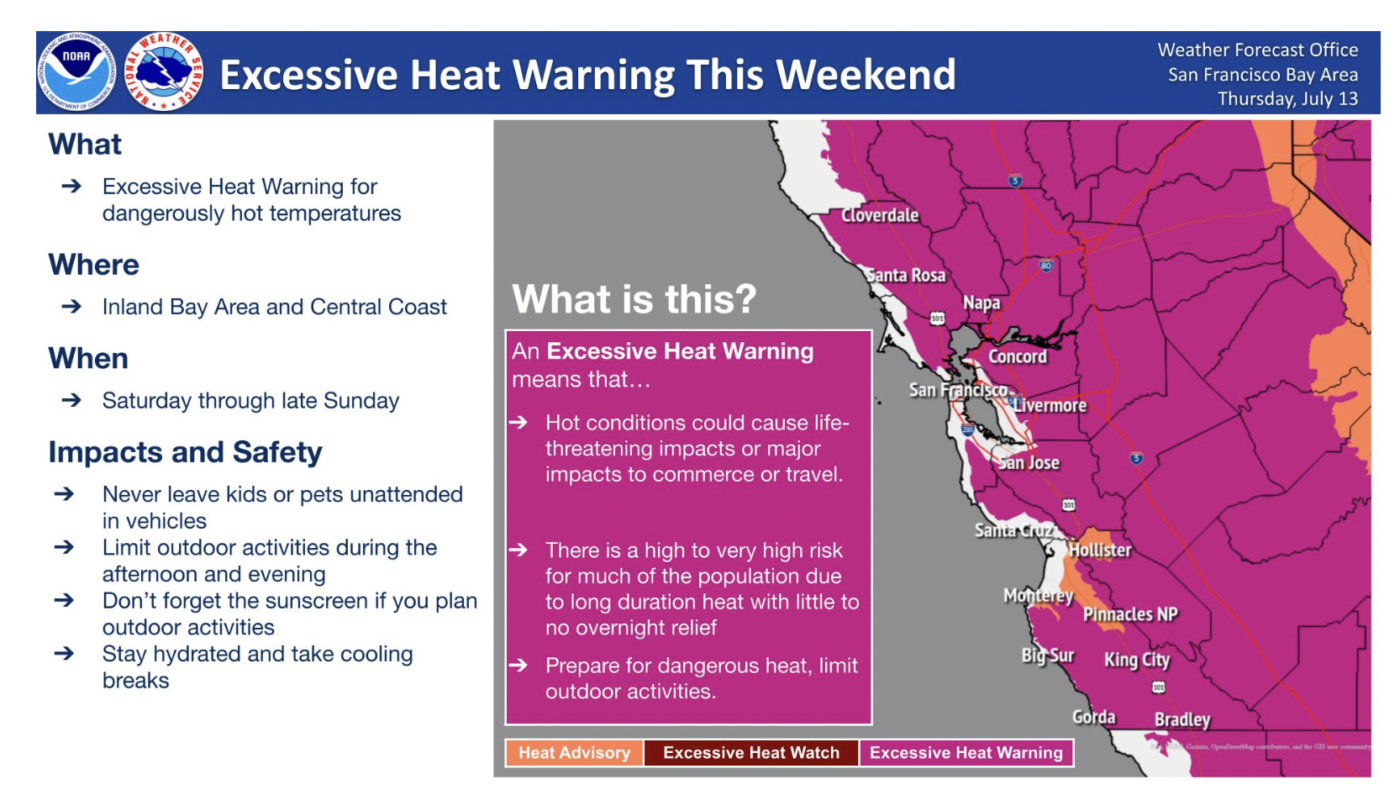As much of the Bay Area braces for a potentially record-breaking heatwave, with an excessive heat warning issued for inland areas, regional authorities offered advice about how best to stay cool, hydrated, and healthy. Here’s a round-up of key information from the National Weather Service, the state’s Heat Ready campaign, and other sources:
Forecast in Piedmont
Thanks to coastal conditions, Piedmont will escape the worst of the heat. Daytime highs are expected to be near 80 degrees Fahrenheit on Saturday and 79 degrees on Sunday, with nights cooling to the high 50s.
Forecast elsewhere
But, anyone venturing to the inland Bay Area through the Caldecott Tunnel, into the North Bay, or south can expect soaring temperatures into the high 90s and triple digits during the day. The National Weather Service advised Friday that inland areas can expect to reach triple-digit temperatures from 11 a.m. Saturday to 11 p.m. Sunday. Only coastal towns and cities are forecast to get (some) reprieve from the heat.
Stay Cool
Avoid being outside in the direct heat for a long time. Try to stay in air-conditioned spaces, at home with the air conditioning set between 75-80 degrees, or at a local library, shopping mall, or community center. If staying home, keep blinds closed and wear loose, light-colored, lightweight clothing.
Hydration
Sip water all day and consider supplementing with sports drinks, and avoid caffeine and alcohol. In addition to water, beverages that contain glucose — such as Gatorade — can also help with hydration, according to family physician Kimberly Chang. Other than Gatorade, an alternative glucose beverage can be made at home using one liter of water, two tablespoons of sugar and one teaspoon of salt, said family nurse practitioner Sandra Young.
Dial Hoang, a meteorologist for the National Weather Service, said this heat wave is concerning because people’s bodies are likely not acclimated to the high temperatures, especially coming out of a long period of cooler-than-usual weather. The excessive heat warning — the highest-level heat advisory from the weather service — means that dangerously hot temperatures could cause major health impacts like heat stroke or exhaustion.
Those in hot areas should watch for symptoms like dehydration, muscle cramps, weakness, nausea, and dizziness. When a person’s internal core temperature rises to a fever, organs like the brain can be impacted, said Dr. Tomas Aragon, director of the California Department of Public Health and the state’s public health officer.
Elderly and neighbors
Look after each other: Check in on friends and family, especially older adults and neighbors and family that do not have air conditioning or who live inland.
“Vulnerable populations like children, pregnant or elderly people, cannot sweat or when they do sweat, they cannot cool down their bodies as effectively,” Hoang said.
Pets
From the California Department of Public Health:
- Exercise pets early in the morning or late in the evening when temperatures are cooler.
- Bring water and take breaks in the shade when walking. Unlike people, pets cannot sweat to effectively cool themselves down.
- Bring pets inside during periods of extreme heat.
- Ensure pets have plenty of shade and shelter if kept outside.
Spare the air
A Spare the Air alert issued Friday now extends to Saturday as hot temperatures are expected to combine with vehicle exhaust to create unhealthy amounts of smog. The Bay Area Air Quality Management District is encouraging people to limit smog levels by avoiding unnecessary trips by car.
People are advised to also limit outdoor exercise to the early morning hours when levels of smog, otherwise known as ozone, are lower. Smog can cause throat irritation, congestion and chest pain and is particularly harmful for children, seniors and people with respiratory or heart conditions, according to the air district.
Cooling centers
Cooling centers are opening around the Bay Area amid an excessive heat warning issued for Saturday and Sunday. In counties like Sonoma, cooling centers are just one part of new plans to respond to extreme weather. Temperatures in the 90s to 110 were projected for parts of North, East, and South Bay, as well as areas of Santa Cruz and the Central Coast. The National Weather Service noted the increased risk of fires and heat-related illnesses, especially for those working outdoors.
“As these extreme weather events become more frequent, the sustainability of support systems will rely on the collaborative work we do with partners, faith groups, nonprofits and local jurisdictions,” Sonoma County emergency management director Jeff DuVall said in a news release. “No one group or entity can take on climate change response alone.”
View a map of cooling centers in the area HERE.
